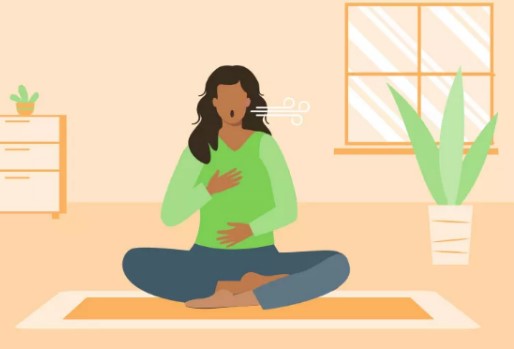
Most of us recognize those two common words which we frequently say to others and hear from them.
What actually works cannot be achieved through mere desire alone. Relaxing can be hard work.
Throughout his entire life journey B.K.S. Iyengar dedicated himself to yoga instruction while promoting its medical benefits for curing illness and stress-related disorders around the globe. The India guru who lived until 2014 at 95 years old explained savasana or corpse pose as one of the most difficult poses to master because constant thoughts persist in the mind.
Four effective methods will help you relax your mind as explained below:
Just Breathe
Breathing deliberately while focusing on mindfulness helps the body enter a state of calmness.
The medical expert Dr. Andrew Weil states that regular controlled breathing promotes peace while fighting stress-linked health conditions that include panic attacks and digestive problems.
He recommends simple 4-7-8 breathing exercise as a natural tranquilizing method for the nervous system.
- Let all air escape your mouth while you create the sound of a whoosh.
- Take in air through your nostrils while keeping your mouth closed to a mental count of 4 seconds.
- Take 7 full breaths in a closed mouth.
- Through your mouth promote a whooshing sound while breath exhaling during an eight-second count.
- This is one breath. Perform the cycle again for a total of four breaths while inhaling.
Breath and Movement = Yoga
Through Yoga you engage in mind-body activities which consolidate directed breathing with deliberate physical body positions called asanas. Yoga presents itself through numerous approaches and difficulty levels. The practice finds new admirers from every segment of society including all age brackets.
The number of Americans who practice yoga in the U.S has increased from 20.4 million in 2012 to 36.7 million in 2016 based on the findings from the 2016 Yoga in America Study. Men presently make up 10 million out of 36.7 million yoga practitioners whereas 4 million were practicing in 2012. Nearly 14 million practitioners are above fifty years old.
AARP reports why numerous elderly individuals are currently taking up yoga.
After receiving media coverage thirty-five years ago cardiologist Dean Ornish M.D. documented his findings that heart disease could be reversed through the combination of yoga and meditation together with healthier exercise routines and nutritional choices. The number of research studies about yoga health effects has dramatically increased since Dr. Dean Ornish made headlines about heart disease reversal through yoga and meditation practice according to Amy Paturel.
Medical evidence demonstrates that yoga practice delivers numerous health advantages for adults.
- Minimizes hypertension;
- Strengthens bones;
- Improves balance;
- Reduces anxiety.
Most people practice yoga for three key reasons that include pleasure from practicing yoga as well as health improvements and stress reduction.
Several scientific studies establish that yoga practice reduces anxiety symptoms as well as eases stress. The Mayo Clinic confirms that practicing yoga increases personal well-being while enhancing your mood according to their research.
The start of yoga practice becomes accessible through either community or health center beginner sessions or by using yoga DVDs and online videos. The correct approach to deep relaxation can be found through a restorative yoga class or video. Restorative yoga poses involve supported positions that require extended periods of five minutes and more.
Give Tai Chi a Try
As a Chinese form of exercise tai chi involves slow purposeful movements with deep breathing while performing its series of movements
People of various ages and fitness levels should find tai chi safe because it places minimal strain on their muscular and joint structures. History shows that tai chi works well as a low impact exercise to serve older adults who avoid regular exercise activities. The Mayo Clinic agrees with this statement.
Through non-aggressive body positions people can fight stress as they simultaneously develop their musculature while increasing flexibility and balancing their movements.
The Osher Research Center at Harvard Medical School hosts a research program under Peter M. Wayne who states that scientific investigations confirm tai chi functionality as a supportive medical treatment for age-related conditions.
People can easily locate Tai chi classes through physical and online platforms that offer classes or DVD rentals. Some locations provide Water Tai Chi classes to their participants.
Short Meditation Sessions Should Be Added
Tai chi exists as a form which people describe as “meditation in motion.” Meditation which does not involve physical movement serves to deliver multiple wellness advantages such as enhanced restful sleep together with both mental relaxation and stress reduction.
Meditation constitutes a fundamental system which prepares the mind for training. The human mind spends most of its time moving between thoughts of future events and memories of past moments while generating worry and making up fantasies and fretting and daydreaming sequences. The present moment brings us through meditation which provides us the needed tools to lower our stress levels and maintain calmness and develop more compassion towards ourselves and others according to New York Times journalist David Gelles.
The steps Gelles presents for basic meditation range from one minute up to thirty minutes and include the following protocol:
- Go to a calm spot to sit using a posture which combines alertness and relaxation.
- Use either total or slight eye openness as you gradually breathe in multiple deep and slow breaths.
- Feel the physical sensations in your body without losing your position of rest.
- Keep your attention on one chosen sensation like your breathing process.
- It is natural for the mind to drift so gently return your attention to your chosen point of focus.
- After the practice concludes you should open your eyes while retaining mindfulness and calmness which will extend to your entire day.

